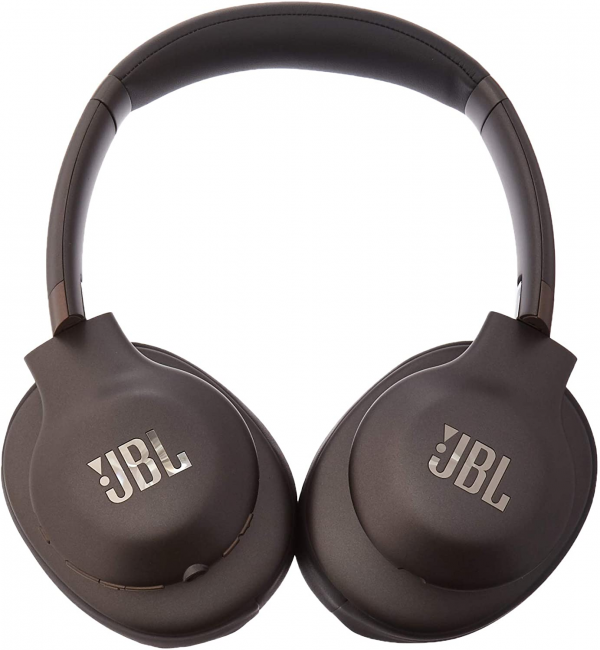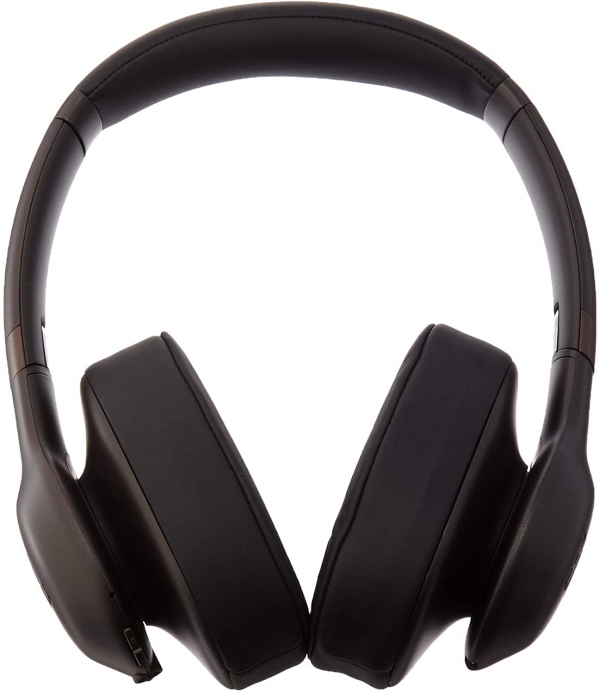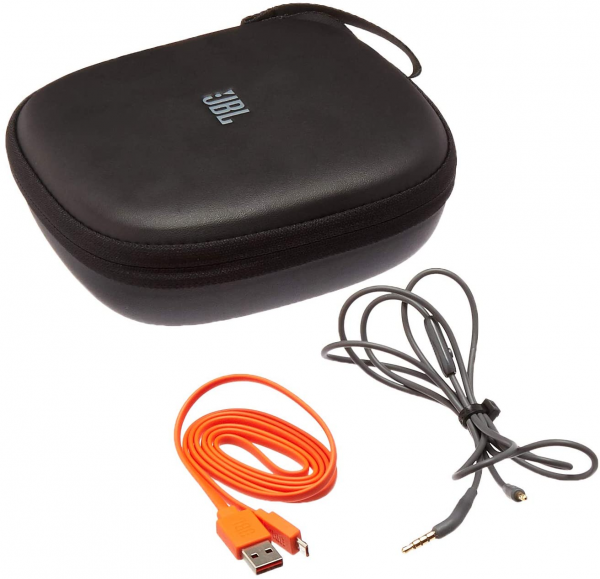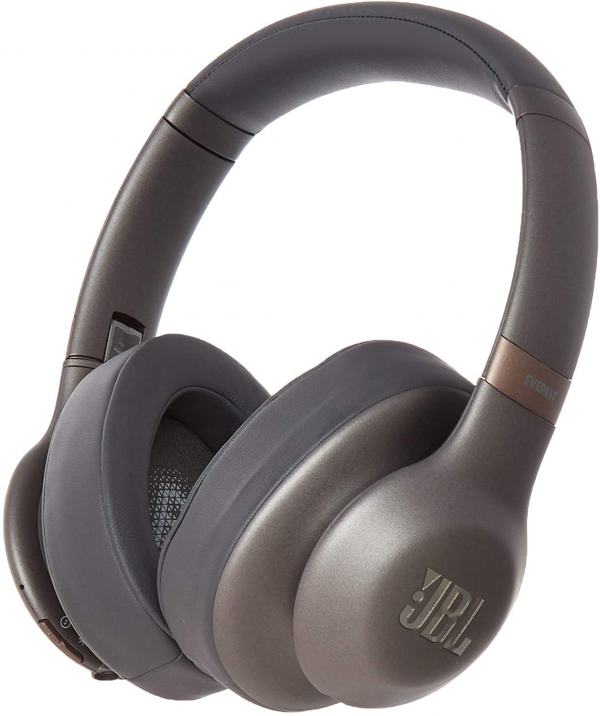JBL
JBL Everest 710: bold wireless headphones
Aprox. 129€ - see price -
Launched at € 249, the Everest 710 belongs to the 2017 generation of mobile helmets at JBL and wants to position itself as the benchmark model for those seeking a comfort and listening experience of first choice. Dispensed with active noise reduction (unlike the Elite 750NC), these headphones also capitalize on its ShareMe 2.0 function, which would make it easy to share listening with another wireless headset. Let's find out what's in his stomach ...
Our review
Ergonomics
In appearance, the Everest 710 largely takes up the formula used on the first generation (Everest 700, etc.): very rounded shapes, rather imposing atria and an arch that runs through the entire helmet. Although it is almost entirely protected with plastic - and we would have liked a little more density at this level - the Everest 710 is distinguished by a particularly light (268 g) and flexible design. It is not afraid of twisting, its ear cups rotate flat (90 °) and it is possible to fold the headband to facilitate the storage and transport of the helmet. A large rigid pocket is also provided to protect it to the maximum.
The arch, whose base is made of aluminum, has been reworked since the previous version and that's a good thing. Forget the rubber covering and its very average comfort experience; the shape and pad here provide a wider head rest, lighter and softer. In addition, the larger deployment (from 32 to 44 cm approximately, by measuring from ear to ear and passing through the top of the head) can adapt to large heads as to small ones. Small note however: the helmet has a very slight tendency to slide backwards. So remember to tighten it a little more or wear it well in the center of the head.
The ball joint system between the headband and the ear cups is still effective. The pressure points are distributed homogeneously, over many types of morphology. The contact with the imitation leather covering is pleasant. The memory foam is not ultra dense, but it has the advantage of being thick, which ensures a good compromise between comfort and feeling of warmth. Although this is not often a problem, we would have preferred to find a little more space between the pads and the speaker protection grille; in some people, the pavilions may slightly touch the grid. Passive insulation is not straightforward on this model: you will be able to cut off a minimum of the surrounding sounds, but you will quickly notice the limits in more demanding places, such as public transport or noisy streets.
The JBL Everest 710 offers a complete user experience, through numerous controls and multiple audio and voice aids (in English only). We find a very reactive monostable switch to turn the headphones on or off, a series of three buttons for volume control, navigate between tracks, manage playback and calls, as well as two other buttons to start pairing and the ShareMe 2.0 function. About pairing precisely, it is very easy and very fast, even in the absence of an NFC chip. The small button simplifies handling when you want to connect a second device to the headset without disconnecting the first. Note that if some buttons have polarization, it may be difficult to differentiate between the volume buttons and the multifunction button at the start. It took us a few sessions to instinctively know the position of the buttons.
The ShareMe 2.0 function, although only a little more, is very practical and easy to use. After pressing the dedicated button, the headphones begin to search for another receiver to share the sound source. The sine qua non condition for establishing the connection is to ensure that no other device, except the one that we are trying to connect, is waiting for Bluetooth pairing in the vicinity. That done, it is possible to enjoy the same content simultaneously on both headsets, or even on headphones and a speaker, for example.
The JBL Everest 710 promises 25 hours of battery life. In practice, we were able to briskly exceed this threshold by going up to more than 35 hours of use with a full recharge - enough to take advantage of long listening sessions repeatedly before recharging.
On the other hand, the microphone housed in the helmet and used wirelessly is hardly convincing. It can possibly be used if you are in a calm environment, but it is better to avoid using it outside if you want to be understood by your interlocutor. Indeed, the noise reduction algorithm does not clearly differentiate spurious sounds from voice, which confuses it considerably. Go on cable if you are outside and want to make a phone call: the microphone housed in the control is not very directive and therefore still captures surrounding sounds, in addition to your voice, but the result will not be as catastrophic as wireless.

Audio
Let us say at the outset: it was difficult for us to assess this helmet at its fair value. Indeed, it is one of those headsets which, despite a very marked sound signature, offer a flattering listening rather homogeneous and coherent. We strongly recommend that you try it before you take the plunge, as some aspects can be divisive. If you are looking for a faithful reproduction or if you like calm bass, head to another model.
The Everest 710 draws a frequency response curve in W, whether wired or wireless. Here, it is the low midrange / midrange and the high midrange that are quite clearly in the background. The bass responds very early. The recoil of the low mids reinforces the round, ample, diffuse and deep aspect, as well as the feeling of pressure brought by the bass / bass extremes, below 150 Hz. The bass is a minimum controlled to contain their amplitude and does not not generate significant masking effects. We detect a minimum the different elements that operate in this register, but we would have really appreciated a better definition and more precision in this area to clarify the slightly veiled aspect that remains and contain some small resonances that appear here and there.
The mediums are tightened around 800-1 700 Hz, which highlights the presence of many sources and the impactful side of certain percussions, without really preserving the purely sharp and "clear" aspect of the sound usually coming from high mediums. The Elite 710 attacks the treble in a fairly localized way, which tends to boost the brilliance of the cymbals and very slightly the whistling (the "s" and "f" of the voice in particular). A more subtle treatment would not have been too much, but we quickly forget this trend. The very good presence of the treble extremes greatly serves the Everest 710. It brings a feeling of air and significant space, coming to widen the sound scene and untie the various elements which compose it. We are far from having something surgical, but we can appreciate a minimum of space and subtle elements (reverberation effects, echo, instruments in the background, even third plane ...).
The Everest 710 is particularly powerful. It is also easy to supply by wired connection: you will have no trouble using it with your smartphone, for example (it needs 150 mVrms to reach 94 dB SPL in wired mode). Be careful though if you are used to a very sustained level of listening: the distortion slowly begins to wake up when you push the headphones into their entrenchments. Precision in the bass and midrange can suffer.
Wireless communication latency is around 170 ms. We can therefore follow a film or video quite comfortably without being disturbed by too great a discrepancy between image and sound. We could have expected greater latency with the ShareMe 2.0 function, but it is so well managed that almost no (or no) difference is detected with or without another headset connected. It is possible to watch a video for two, which is a nice surprise.

Conclusion
The JBL Everest 710 is a comfortable and enduring wireless listening companion that provides a complete user experience. Because of its very marked sound signature, we strongly advise you to listen to it before buying it. If you do not have the opportunity or want to take less risk, it is possible to find other more balanced references: we can mention the BackBeat Pro 1 and 2, the HD 4.50 BTNC Wireless, the Bluetooth Monitor or even Listen Wireless for example.

Reviews


Lackluster and bad sound quality.
Recently I owned a JBL Everest Elite 700, which I must say was a phenomenal product, it lasted me 2 years and produced fantastic sound quality and noise cancellation, not to mention the ear-pieces were amazing quality.
Moving forward to today, I just received my JBL Everest 710 Headphones and tested them out. Here's my take:
Pros:
- Easy to turn on and pair to BT device
-Light weight and good cosmetics
- For some, I imagine the concept of this device (where you can Share, or connect to two different BT device at once) had some appeal, though I do not understand why anyone would actually want this feature ...
Cons:
- Earpieces are not very nice, they are not ultra fluffy, but they are not terrible either (esp. Compared to the Elite)
- Sound quality is lackluster, and easily on par with a rubbish pair of Ipod headphones, it is not better than Ipod headphones.
- there is no real effective noise cancellation ....
Overall this purchase was a disappointment, but I guess you get what you pay for ($ 134?) - cheap Chinese made material. I expect it will break / crash in a matter of weeks to months, but we'll see how long it actually lasts. Coming from using the Elite 700, the product was lackluster at best. The Elite 700 was so much better it is unbelievable, as if this product I purchased was counterfeit.
A great part of the Elite 700 was that it would allow you to modulate the noise cancellation by turning "Ambient Aware On / Off" - this feature is not present in the 710. Right now I'll be looking to repair my Elite 700 headphones as they were legit / superior. I bought the 710s thinking they would be as good (or better), but I was mistaken ....
----
EDIT - In retrospect, I realize my original review may have been a little too harsh, the sound quality is pretty OK, but surely not as good as the Elite 700 (they are indeed significantly * better * than Ipod headphones though, and are likely not counterfeit as I harshly suggested).
Even though there were some reviews about the quality of ...
Even though there were some reviews about the quality of the sound, I thought the sound was ok. However, the power of it was to low. The sound volume was not powerful as I expected.
I test different brands and products often...
2nd pairs of JBL in less than 2 weeks! Bought the rose gold ones ... the buttons didnt work upon set up. Returned and purchased these ... AND guess what? They didnt work either! Everytime I connected provided cable to product they automatically shut off. I could not use these to connect to computer due to them shutting off automatically when inserting provided Aux cable. I am so disappointed in JBL. I get all brand products for free and test different brands. They used to be my favorite brand for quality, now that's changed drastically in the last 2 years. Bummed.
Waste of Money!
Please do NOT buy this piece of (fill in the blank with a colorful word of your choice)! Pay a little more and buy another brand and do your hard earned dollars a huge favor.
Sound quality is crazy good. However they will wear in quick time.
Sounds great. Breaks easily in less than one year. Warranty nonexistent. Destroyed leather ear covers sweatshirt.
Pretty balanced sound
Everest 710 is perfect for who is looking for a balanced sound. The sound is pretty clear and brilliant. Very comfortable. I used for 6 hours in a travel and it was perfect. If you are looking for a punch of bass it's not the right headphone but the Everest 710's bass is very nice.